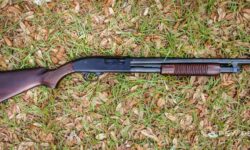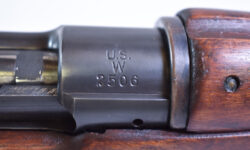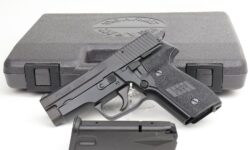HOW TO LOAD A SHOTGUN?
Shotguns are one (if not) of the most powerful firearms you can get as a civilian. It is extremely lethal on close range and you can trade between power and accuracy by using shots (which are essentially pellets) or slugs. Shotguns are one of the most versatile firearms on the market due to the variety of shells or shots you can load and fire. For this article, we’ll discuss the best ways to load and unload a shotgun so you can make the most of your shotguns without hurting yourself or others.
How to Load a Shotgun Correctly?
Shotgun Types
Before we get into details let’s identify and differentiate the different types of shotguns you might own or encounter on a gun range:
Break Action Shotguns – One of the oldest types of shotguns still in use today is the break-action shotguns. As the name suggests, break-action shotguns break the barrel open with a hinge to load and unload shells.
Lever Action Shotguns – Break action shotguns were one of the most common guns to own in the 19th century. That all changed in the 1860s with the release of the lever-action repeating rifle. It was easier to use and holds a lot more bullets. Following the trend, lever-action shotguns were also made. This held more shells, and it was very easy to fire multiple shots.
Pump Action and Semi-Auto Shotguns – In the modern era, the shotgun choice for security and law enforcement are pump-action and semi-automatic shotguns. These shotguns load shells in a magazine found integrated with the barrel. The pump-action shotguns load shells and primes the firing pin by pumping the forearm. While the semi-auto and full-auto shotguns have a more complex mechanism to automatically load and eject shells making them the most practical in tactical applications.
Loading and Unloading Shotguns
The general rule for loading any firearm is to make sure that it’s unloaded first, but the thing is, we have no way of immediately knowing whether a firearm is loaded or not and that leads us to our first rule:
- ALWAYS TREAT A GUN AS IF IT’S LOADED
Keeping the first rule in mind here are the rules for handling a firearm:
- Make sure to point your firearm in a safe direction and make sure that the safety is on and make sure that your fingers are off the trigger at all times unless you’re ready to fire.
- If you’re unloading and loading, make sure that the firearm is safe to handle, this means you have to check that the gun is empty or all shots are fired.
- If you don’t need to fire the remaining bullets or shells, make sure to unload them safely.
Different types of shotguns require different types of loading and unloading mechanisms, here’s how to unload and load specific types of shotguns.
Break action
And if it’s available, wear protective goggles before handling a break action shotgun. Once you handle a break action shotgun, point the muzzle in a safe direction, finger off the trigger, and safety on. Before you crack open your break action shotgun, remember that most of these guns have a mechanism that’ll automatically eject the empty shells as you are breaking the gun open. So it’s very important not to stare at the shotgun barrel while opening it especially if you just fired the gun (This is where a pair of protective goggles might come in handy).
If your break action shotgun doesn’t have an ejector or if the shells became jammed, make sure to wear a tactical glove, that way you can avoid getting burnt by the recently fired shells.
Once fully unloaded and safe. Gently insert your fresh shells into your break action shotgun. Make sure that the shells are firmly in place since you need to hear a click in some shotguns to determine that the shell is loaded correctly. Once you went over everything, close your shotgun, turn off safety while pointing in a safe direction, and if you’re ready point the shotgun at your target, and only then should you put your finger on the trigger and fire!
Lever Action Shotguns
This type of shotguns often has the same mechanisms as a lever-action rifle counterpart. Thus they operate very similarly. Before unloading and checking a gun, make sure to observe gun safety by pointing the gun in a safe direction and keeping your finger out of the trigger, this is of utmost importance since some lever-action shotguns will need the safety turned off to manipulate the lever. Once it is safe, operate the lever at least twice to make sure that the shotgun is empty. If shells came out, operate the lever until there are no more shells. At this point, you can cock the lever forward to open the loading port to visually inspect the barrel and magazine to make sure that no shells are remaining.
To load a lever-action shotgun insert a shell on the barrel while the lever is open. Then close the lever. At this point, the gun is live so make sure to turn your safety on. After that, you can insert more shells on the side or bottom magazine until it’s full. After that, you can point your shotgun, turn the safety off, and fire.
Pump Action Shotgun
Just like the lever-action shotgun, you just have to pump the action to check if the gun is empty, if no shells are ejecting, slide the forearm backward and visually inspect the barrel and magazine if it’s empty. If you can’t pump the action, that means that the gun is loaded and ready to fire. To unload a loaded gun simply turn the safety on and press the action release commonly found outside the trigger guard, and proceed to unload all shells by pumping the forearm. As a safety measure pump the forearm once more and the gun is now safely unloaded.
To load a pump-action shotgun, insert one shell while the forearm is pumped back and the loading port is open. After that slide the forearm forward, at this point, the gun is loaded and ready to fire so make sure that your safety is on. After that, you can now load more shells on the magazine loading port on the side or under the gun until it’s full. At this point, your shotgun is now fully loaded and ready to fire.
Semi-Auto and Full-Auto Shotguns
Semi and Full auto shotguns are mostly bolt actions with a very rare exception of pump-action semi-auto shotguns. To unload automatic shotguns, simply pull the bolt handle, and if a shell doesn’t come out, visually inspect the barrel and magazine. If a shell ejects upon pulling the handle or if you found remaining shells upon inspection, there are different ways to unload an automatic type shotgun. One way of doing it is by repeatedly pulling back the bolt action until all shells are ejected. Another faster way of doing it is by pushing the magazine port and pressing the magazine release button. That’s a way to do it IF it’s available on your gun.
Loading automatic shotguns is very similar to pump actions. Slide the bolt handle back to open the loading/ejection port and simply insert one shell and pull back the bolt once more to close it. After loading the first shell, make sure the safety is on, and then insert more shells into the loading port on the bottom until it’s full. The gun is fully loaded at this point.
Conclusion:
In reality, loading and unloading a gun you know or own is as easy as firing it. The hardest and most important part is making sure that a gun is safe to handle and operate at all times. Sure you can skip around all these safety procedures, but I’d stick around to safety if I were you, considering that accidental firing happens all the time. And doing these safety procedures ensures you a lower chance of having your gun blowing up on your face. Fire responsibly!
[sc name=”faq2questions” q1=”How to load a shotgun?” a1=”Before we get into details let’s identify and differentiate the different types of shotguns you might own or encounter on a gun range…” q2=”Loading and Unloading Shotguns” a2=”The general rule for loading any firearm is to make sure that it’s unloaded first, but …” ]


